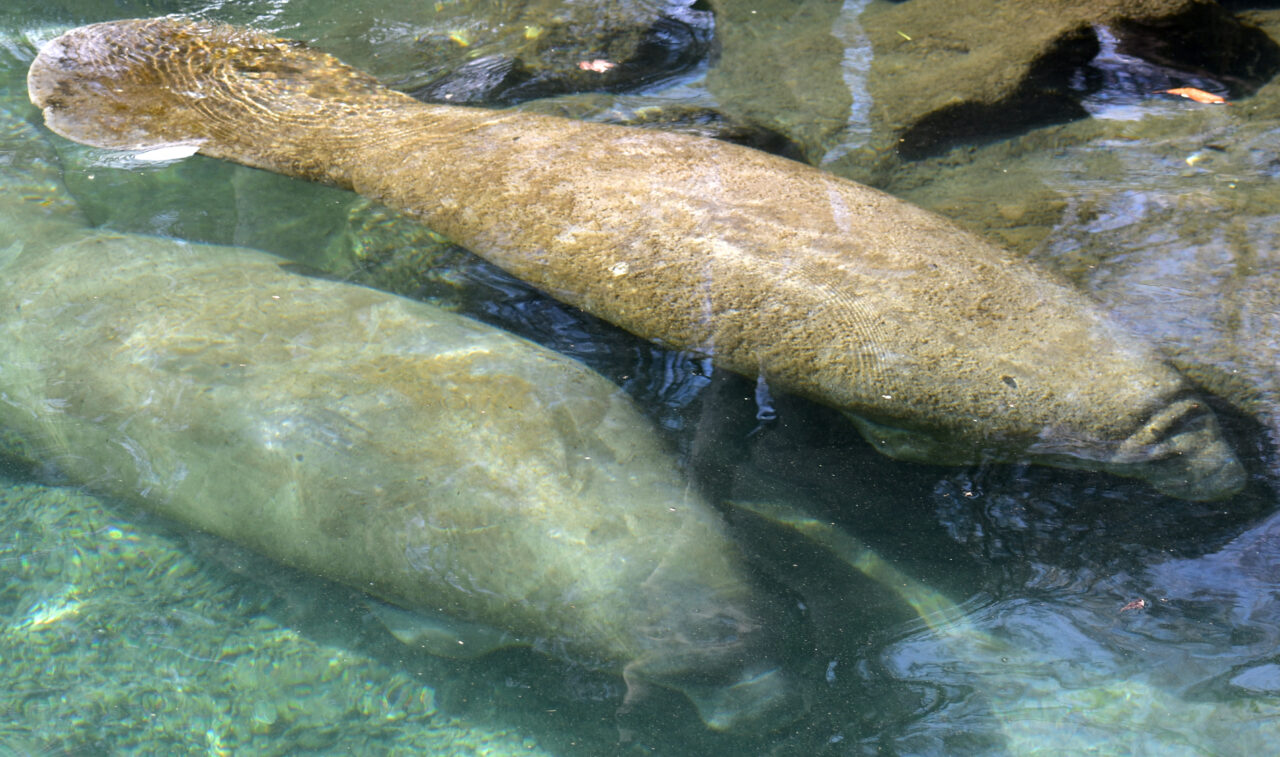
Lluvia and her calf Morado glide to the bottom of their habitat to munch on romaine lettuce during hour one of the eight they spend eating daily.
They are the lucky ones, survivors from what wildlife experts are worried could be another year full of unusually high deaths among Florida’s beloved manatees.
Already, state officials reported late Wednesday at least 56 manatees dead so far during 2023 — compared to 39 during the same period last year, which was the second-deadliest year on record. This year’s dead include three from boat encounters, 10 related to births and eight from Florida’s recent severe cold spell. Officials said they haven’t determined the cause of 29 of this year’s deaths yet.
In Tampa, Lluvia, Morado and 13 other manatees rescued from the state’s west coast are recovering from injury or illness at ZooTampa’s David A Straz Jr. Manatee Critical Care Center, one of 13 such rescue centers in the United States. Rescuers here hope to release them back into the wild.
What awaits other manatees in the wild across Florida’s bays, canals and marshes this year is anyone’s guess so far. Meghan Cohorst, a spokeswoman for the Maitland nonprofit Save the Manatee Club, said it is too soon to speculate.
Accidents with boats — usually spinning propellers — send manatees to the critical care facility at ZooTampa, said Molly Lippincott, curator of Florida manatees at the zoo. But for their East Coast relatives, the problem lies with food shortages on the Indian River Lagoon’s floor.
“Researchers expect findings of chronic malnutrition in manatees to persist along the Atlantic coast so long as there remains a seagrass shortage in the Indian River Lagoon,” the Florida Fish and Wildlife Conservation Commission said in a statement this week.
In 2020, wildlife experts declared an “unusual mortality event” after widespread deaths of manatees, largely due to starvation. The deaths made national headlines. When the cow-size, aquatic mammals moved inland for warmer waters in the winter, they found an insufficient amount of seagrass in the Indian River Lagoon to sustain them. Since 2009, the lagoon has lost about 75% of the 80,000 acres of seagrass it once had, St. Johns Water Management District environmental scientist Charles Jacoby said.
Now, statewide seagrass restoration efforts and small-scale supplemental manatee feedings hope to prevent another record year of mortality. But the early death figures so far this year aren’t promising.
The U.S. Fish and Wildlife Service and the state wildlife commission co-manage the Florida manatee response efforts. The two organizations began feeding manatees last winter and continue to feed as many as 230 manatees so far this season.
Starvation-related mortality has been much lower this winter, according to the state wildlife agency. Researchers fear they will see chronic malnutrition in manatees along the East Coast in Florida as the seagrass shortage persists.
Lippincott said the number of rescues so far is less than previous years, but they won’t know the effects of the winter’s cold fronts for a few months. Malnutrition can make manatees vulnerable to cold stress, a condition she said affects their skin like frostbite and can also lead to pneumonia.
One of the primary goals for the small-scale feeding trial is to reduce the number of animals in need of rescue. The state wildlife agency reported 16 rescued manatees this year, and three were released.
None of the manatees at the Tampa rescue center were suffering from starvation, Lippincott said, but the recent wave of deaths among manatees has raised awareness among the public — and in the Legislature — about their struggles.
“We need to save as many animals as we can,” Lippincott said. “Save the ones that are critical now with the intention that seagrass restoration efforts are going to make a difference in the long run.”
The Department of Environmental Protection and its partners work to restore seagrasses, which are vital to water quality and serve as the manatee’s go-to vegetation for grazing.
Since 2019, the state has dedicated $1.6 billion to restoration projects, said Alex Reed, the Department’s director of water resource management, in a presentation to Senators earlier this month. The Department is working on about 950 projects statewide with this money, which resulted in significant phosphorus and nitrogen reductions.
Jacoby, the government scientist, said water quality in the Indian River Lagoon is already improving.
“We’re not likely to plant our way back to health,” Jacoby said. “Water quality is a key part of it.”
Nonprofit organizations like Tampa Bay Watch are working on their own water quality improvement and seagrass transplant projects. The group’s president, Peter Clark, said the local concern is preventing an ecosystem collapse like the one that happened in Indian River Lagoon.
The bay has lost around 81% of its seagrass beds, Clark said.
Most of that has come in the upper Tampa Bay, where manatees migrate for warmer water in the winter. In past transplant projects, the group has provided seagrasses near such locations.
“You cannot depend on transplanting seagrass to solve all the issues in the bay,” Clark said. “You’ve got to deal with water quality. You’ve got to deal with development issues to be able to generate the thousands of acres that are needed.”
Monitoring water quality includes making sure wastewater treatment plants are discharging with advanced levels of treatment, reducing industrial sources entering the water and dealing with stormwater runoff. New development requires stormwater treatment before it leaves the property, Clark said, but older development in the state needs to be remedied.
The Indian River Lagoon saw good seagrass progress in 2021 and 2022, Jacoby said, but it could take about 17 years to return to its past abundance.
___
This story was produced by Fresh Take Florida, a news service of the University of Florida College of Journalism and Communications. The reporter can be reached at [email protected]. You can donate to support our students here.



